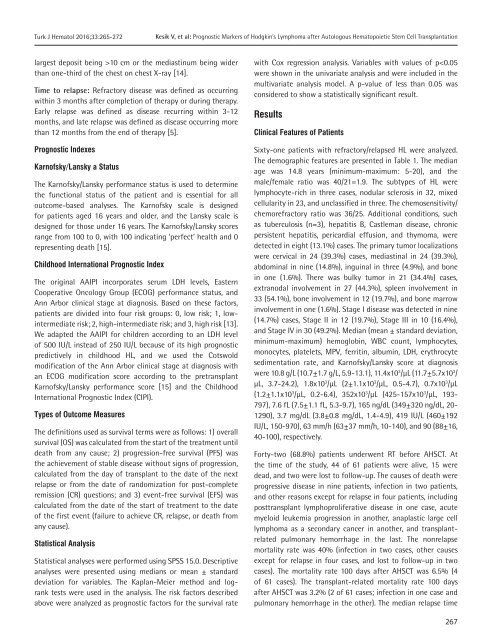Turkish Journal of Hematology Volume: 33 - Issue: 4
Create successful ePaper yourself
Turn your PDF publications into a flip-book with our unique Google optimized e-Paper software.
Turk J Hematol 2016;<strong>33</strong>:265-272<br />
Kesik V, et al: Prognostic Markers <strong>of</strong> Hodgkin’s Lymphoma after Autologous Hematopoietic Stem Cell Transplantation<br />
largest deposit being >10 cm or the mediastinum being wider<br />
than one-third <strong>of</strong> the chest on chest X-ray [14].<br />
Time to relapse: Refractory disease was defined as occurring<br />
within 3 months after completion <strong>of</strong> therapy or during therapy.<br />
Early relapse was defined as disease recurring within 3-12<br />
months, and late relapse was defined as disease occurring more<br />
than 12 months from the end <strong>of</strong> therapy [5].<br />
Prognostic Indexes<br />
Karn<strong>of</strong>sky/Lansky a Status<br />
The Karn<strong>of</strong>sky/Lansky performance status is used to determine<br />
the functional status <strong>of</strong> the patient and is essential for all<br />
outcome-based analyses. The Karn<strong>of</strong>sky scale is designed<br />
for patients aged 16 years and older, and the Lansky scale is<br />
designed for those under 16 years. The Karn<strong>of</strong>sky/Lansky scores<br />
range from 100 to 0, with 100 indicating ‘perfect’ health and 0<br />
representing death [15].<br />
Childhood International Prognostic Index<br />
The original AAIPI incorporates serum LDH levels, Eastern<br />
Cooperative Oncology Group (ECOG) performance status, and<br />
Ann Arbor clinical stage at diagnosis. Based on these factors,<br />
patients are divided into four risk groups: 0, low risk; 1, lowintermediate<br />
risk; 2, high-intermediate risk; and 3, high risk [13].<br />
We adapted the AAIPI for children according to an LDH level<br />
<strong>of</strong> 500 IU/L instead <strong>of</strong> 250 IU/L because <strong>of</strong> its high prognostic<br />
predictively in childhood HL, and we used the Cotswold<br />
modification <strong>of</strong> the Ann Arbor clinical stage at diagnosis with<br />
an ECOG modification score according to the pretransplant<br />
Karn<strong>of</strong>sky/Lansky performance score [15] and the Childhood<br />
International Prognostic Index (CIPI).<br />
Types <strong>of</strong> Outcome Measures<br />
The definitions used as survival terms were as follows: 1) overall<br />
survival (OS) was calculated from the start <strong>of</strong> the treatment until<br />
death from any cause; 2) progression-free survival (PFS) was<br />
the achievement <strong>of</strong> stable disease without signs <strong>of</strong> progression,<br />
calculated from the day <strong>of</strong> transplant to the date <strong>of</strong> the next<br />
relapse or from the date <strong>of</strong> randomization for post-complete<br />
remission (CR) questions; and 3) event-free survival (EFS) was<br />
calculated from the date <strong>of</strong> the start <strong>of</strong> treatment to the date<br />
<strong>of</strong> the first event (failure to achieve CR, relapse, or death from<br />
any cause).<br />
Statistical Analysis<br />
Statistical analyses were performed using SPSS 15.0. Descriptive<br />
analyses were presented using medians or mean ± standard<br />
deviation for variables. The Kaplan-Meier method and logrank<br />
tests were used in the analysis. The risk factors described<br />
above were analyzed as prognostic factors for the survival rate<br />
with Cox regression analysis. Variables with values <strong>of</strong> p

















